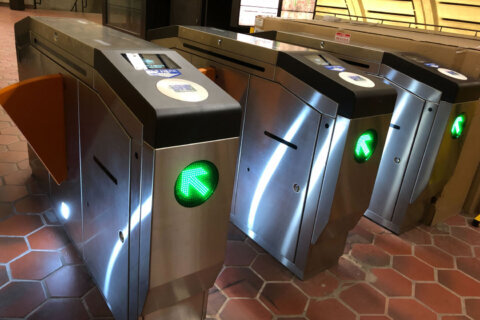Sometime in 2020, you will be able to use your phone to pay to ride Metro or buses across the D.C. region. But how will it actually work?
Phone becomes SmarTrip
Riders who want to pay with a smartphone will essentially need to create a “virtual” SmarTrip on their phones.
Once that account is created — for example, in Apple Wallet — riders can tap their phones anywhere a regular SmarTrip card is accepted, including Metro stations, parking garages, and local and regional bus routes.
When can I do it?
Metro has yet to announce when mobile payments will actually be accepted, although Metro General Manager Paul Wiedefeld is optimistic at least iPhone and Apple Watch payments will be active this winter.
“Every station, every line, every bus, all on the same day,” Wiedefeld said of the planned rollout.
Other mobile pay options, such as Google Pay on Android, are also likely to launch in 2020.
Last year, Metro had said it hoped to have payments activated by the end of 2019.
“We have completed the back-end work that will soon enable customers to add SmarTrip cards to their mobile wallets and to use their smartphones to pay on Metro,” Wiedefeld said Thursday.
That includes replacing some of the parts of fare boxes that SmarTrips are tapped to, back-end systems upgrades, links between Metro’s fare payment contractor and the other payment modes, and new payment processing policies and fee agreements.
Metro declined to detail the fee agreements but described them as similar to what Metro pays for credit card transactions.
Metro is also working on its own separate SmarTrip payment app that it hopes to roll out no later than July. Like the SmarTrip website, the app would also allow riders to manage their SmartBenefits.
Why would I want to?
Metro hopes mobile payments finally make it easier for riders to buy unlimited-ride passes and load money onto SmarTrip accounts, which would be key to offsetting some proposed fare increases for next year.
At least some of the mobile payment options will also allow riders to use multiple cards on a single phone, so a family of four could tap a single phone multiple times if they toggle among different cards between each tap.
Metro also believes riders want to pay with their phones to avoid the need to carry around a SmarTrip. “I think it’s fantastic. I think, you know, it’s obviously where we want to be. It’s where the world’s headed,” Wiedefeld said.
SmarTrip cards launched in 1999. A previous effort at new payments, which would have included the ability to tap credit cards on fare gates, was canceled in 2016.
What will I need to do to make this work?
To pay with a phone, riders will need a smartphone with near field communication technology. Most recent phones have that built in.
Riders will need to create a SmartTrip on their phones in Apple Wallet, the SmarTrip app or other accepted payment systems.
That can be done either by going to an online SmarTrip account and adding the phone as a new SmarTrip card or by physically tapping the phone to an existing SmarTrip card that the rider wants to transfer onto the phone.
Using the transfer method will permanently disable the existing SmarTrip card since the phone will essentially take over that card’s serial number and other details.
In Apple Wallet, users will need to create a virtual SmarTrip in the Wallet app by clicking add, then selecting Metro/SmarTrip and following the rest of the instructions. Alternatively, after selecting Metro/SmarTrip, users can select transfer balance from existing card and rest the device on top of the current SmarTrip until “card added” shows up.
Apple supports Express Transit (paying without the need for a Face ID, Touch ID or pass code) on iPhone SE, iPhone 6s or later models, and Apple Watch Series 1 and 2 or later.
The express pay is meant to avoid backups at the fare gates. The phone or watch vibrates and shows a checkmark when the tap registers. The phone or watch does have to be on, but does not have to have cell service or be unlocked in order to pay.
If users have the express mode turned off, a Face ID, Touch ID or pass code verification is required.
Users with multiple virtual cards can toggle among different cards under settings in Apple Pay or the SmarTrip account to determine which one is active or should be set as the default.
Google Pay Transit works in largely the same way as Apple’s version.
What if the battery dies?
Certain new iPhones — the XS, XS Max and XR — have a power reserve feature that shuts the phone down with just enough battery left to pay for rides for up to five hours.
Other riders would not have payment options other than pausing to charge their phones.
Since transactions are all contained on the card or the phone, and not immediately sent to Metro servers, riders cannot tap in with a phone and out with a SmarTrip card or vice versa.
What if I only have cash?
Since the phone essentially becomes a SmarTrip card, users will still be allowed to add cash to their accounts using station fare card machines or at retail stores in the same way the machines work today.
Metro believes nearly all of its riders have smartphones, even those who don’t have bank accounts. They could still add money to the virtual SmarTrip through ApplePay or at the current options of retail stores, on buses or at rail station fare machines.
Can I do this for other rides?
The SmarTrip mobile payment will cover Metro services as well as regional bus systems such as Montgomery County’s Ride On, Prince George’s County’s TheBus, Alexandria’s DASH, Arlington’s ART Bus, Loudoun County Transit, OmniRide in the Prince William and Manassas areas, and Fairfax Connector.
Separate mobile payment systems are already in place for Virginia Railway Express and Maryland Transit Administration services such as MARC Train, commuter bus and Baltimore-area transit systems.
The popular VRE app works by activating tickets on a phone, then showing the screen to a conductor.
The Maryland CharmPass app also allows the purchase of one-way or multi-trip tickets using cash or SmartBenefits. Riders then show the activated ticket to the bus operator or conductor.







